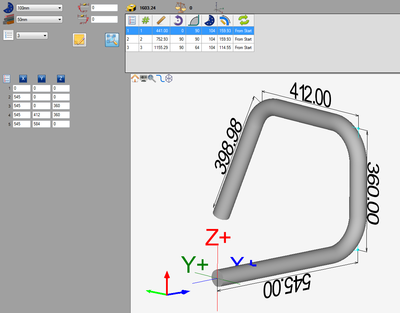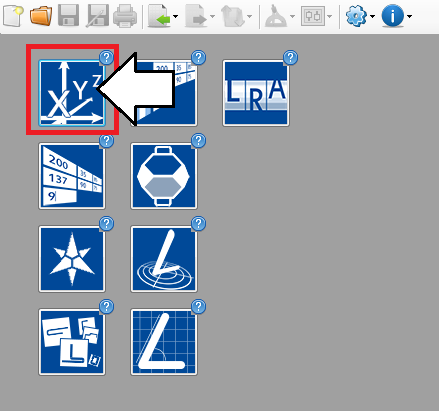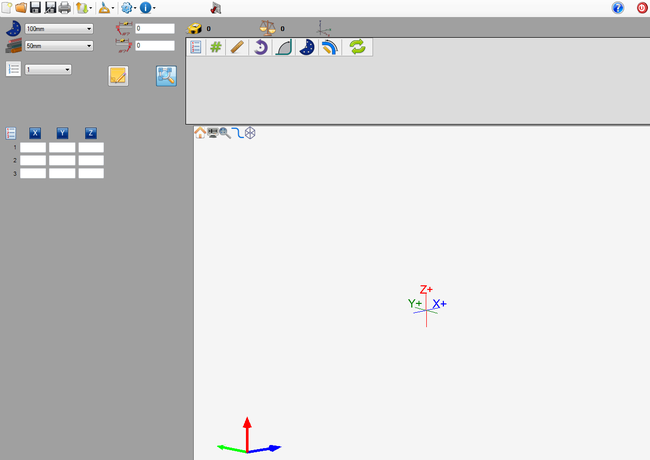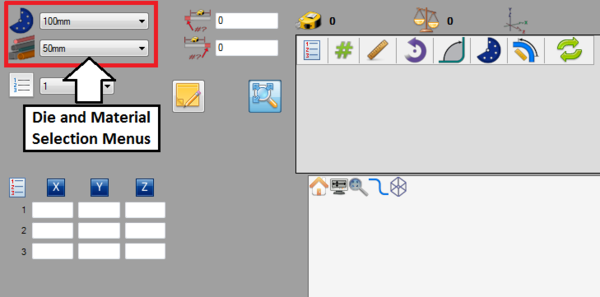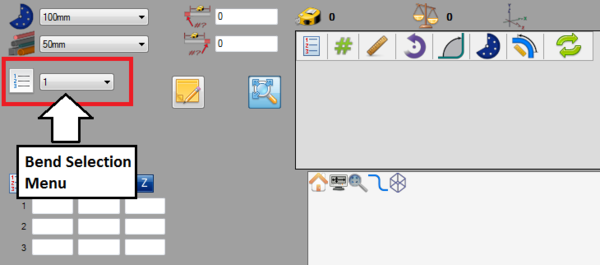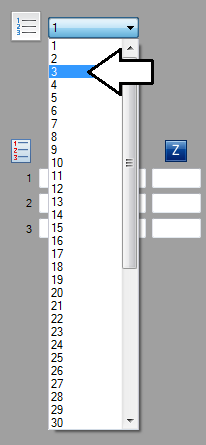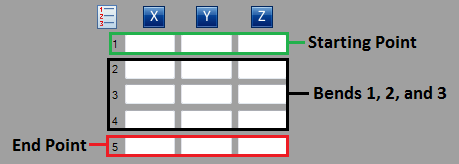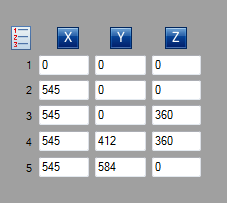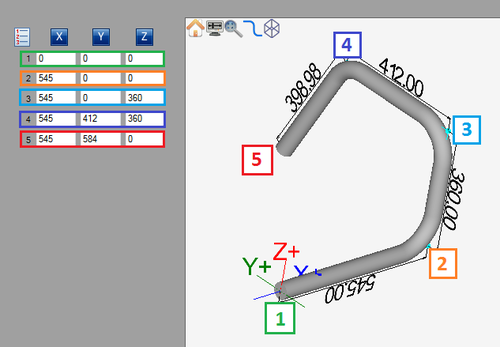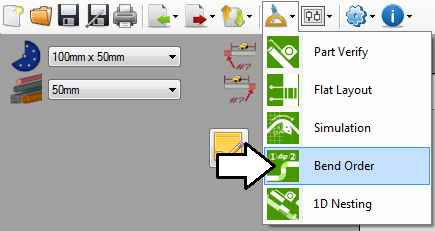Difference between revisions of "XYZ Designer Tutorial"
| (12 intermediate revisions by the same user not shown) | |||
| Line 1: | Line 1: | ||
==Introduction== | ==Introduction== | ||
| + | [[File:xyztut12.png|right|400px]]This tutorial will step through the process of designing a part (''Shown to the right'') in the XYZ part designer interface. | ||
| + | |||
| + | While designing a part in the [[XYZ Designer|XYZ designer]], the die, material, number of bends, and XYZ coordinates are provided to design the part. | ||
| + | |||
| + | '''''Note:''''' ''This tutorial will use millimeters as the measurement units.'' | ||
| + | |||
| + | |||
| + | |||
| + | |||
| + | |||
| + | |||
| + | |||
| + | |||
| + | |||
| + | |||
| + | |||
| + | |||
| + | |||
| + | |||
| + | |||
| + | |||
| − | |||
| − | |||
| Line 9: | Line 28: | ||
==='''Step 1'''=== | ==='''Step 1'''=== | ||
| − | First, a '''new XYZ part design''' needs to be started. On the start up page, click the '''XYZ designer''' button. [[File: | + | First, a '''new XYZ part design''' needs to be started. On the start up page, click the '''XYZ designer''' button. [[File:xyzicon.png]] |
| Line 32: | Line 51: | ||
| − | '''Choose a die''' by clicking the drop down menu next to the die icon. '''Select the 100mm die''' from the list, as shown in the image below. ('''''Note:''''' ''This die was made in the Die Library Tutorial. If this die is not shown in the die selection menu, please complete the die library tutorial before proceeding.'') | + | '''Choose a die''' by clicking the drop down menu next to the die icon. '''Select the 100mm die''' from the list, as shown in the image below. ('''''Note:''''' ''This die was made in the [[Die Library Tutorial]]. If this die is not shown in the die selection menu, please complete the die library tutorial before proceeding.'') |
[[File:temptut8.png]] | [[File:temptut8.png]] | ||
| − | '''Choose a material''' by clicking the drop down menu next to the material icon. '''Select the 50mm material''' from the list, as shown in the image below. ('''''Note:''''' ''This material was made in the Material Library Tutorial. If this material is not shown in the material selection menu, please complete the material library tutorial before proceeding.'') | + | '''Choose a material''' by clicking the drop down menu next to the material icon. '''Select the 50mm material''' from the list, as shown in the image below. ('''''Note:''''' ''This material was made in the [[Material Library Tutorial]]. If this material is not shown in the material selection menu, please complete the material library tutorial before proceeding.'') |
[[File:temptut9.png]] | [[File:temptut9.png]] | ||
| Line 51: | Line 70: | ||
'''Choose the amount of bends''' by clicking the drop down menu next to the bend number icon. '''Select the number 3''' from the list as shown in the image below. | '''Choose the amount of bends''' by clicking the drop down menu next to the bend number icon. '''Select the number 3''' from the list as shown in the image below. | ||
| − | [[File:xyztut7.png | + | [[File:xyztut7.png]] |
| Line 57: | Line 76: | ||
==='''Step 5'''=== | ==='''Step 5'''=== | ||
| − | Once the number of bends has been increased to 3, the coordinate fields will adjust accordingly. There will be 5 rows available now. The first row will define the starting point of the part, rows 2, 3, and 4 will define each bend, and row 5 will define the ending point of the part. See image below. | + | Once the number of bends has been increased to 3, '''the coordinate fields will adjust accordingly'''. There will be 5 rows available now. The first row will define the starting point of the part, rows 2, 3, and 4 will define each bend, and row 5 will define the ending point of the part. See image below. |
[[File:xyztut8.png]] | [[File:xyztut8.png]] | ||
| Line 65: | Line 84: | ||
==='''Step 6'''=== | ==='''Step 6'''=== | ||
| − | '''Now the | + | '''Now the coordinates will be entered'''. The coordinates given here will define the shape of the part. |
| + | |||
| + | On the left side of the window, there will be a series of coordinate entry fields. | ||
| + | |||
| + | '''Enter the exact coordinates''' shown in the image below. | ||
| + | |||
| + | '''''Tip:''''' ''Hitting the tab key will move the cursor to the next available cell. While the cursor is in the last cell of a row, hitting the tab key on the keyboard will move the cursor and generate the previous row's values in the next row.'' | ||
[[File:xyztut9.png]] | [[File:xyztut9.png]] | ||
| + | |||
| + | |||
| + | Each row/set of coordinates represents a specific point on the part, as shown below. | ||
| + | |||
| + | [[File:xyztut10.png|500px]] | ||
| Line 73: | Line 103: | ||
==='''Step 7'''=== | ==='''Step 7'''=== | ||
| + | As each set of coordinate values are supplied, '''the 3D part model will be generated in the [[Graphical Display|graphical display]] to the right'''. Once all coordinates are entered, the complete part will be shown. The part's bend information will also be generated in the '''results table at the top of the window'''. See the image below. | ||
| + | |||
| + | Depending on the options chosen in the [[Program Settings#Results/Output Format|results/output format]] and [[Program Settings#Results/Output Settings|results/output settings]] tabs in the [[Program Settings|program settings menu]], the results table may look slightly different. | ||
| + | |||
| + | |||
| + | [[File:xyztut11.png|600px]] | ||
| + | |||
| + | |||
| + | |||
| + | |||
| + | |||
| + | |||
| + | ==='''Step 8'''=== | ||
| + | '''At this point, the part has been completed!''' | ||
| + | |||
| + | |||
| + | The '''part design file can be saved''' by going up to the main tool bar and clicking the '''save''' option. [[File:temptut13.png]] | ||
| + | |||
| + | |||
| + | The '''bend order''' can also be adjusted in the '''[[Bend Order|bend order]]''' menu. | ||
| + | |||
| + | [[File:temptut14.png]] | ||
| + | |||
| + | |||
| + | The '''part setup sheet''' can also be printed by clicking the '''print''' option on the main tool bar. [[File:temptut15.png]] | ||
Latest revision as of 13:40, 19 August 2013
Contents
Introduction
This tutorial will step through the process of designing a part (Shown to the right) in the XYZ part designer interface.While designing a part in the XYZ designer, the die, material, number of bends, and XYZ coordinates are provided to design the part.
Note: This tutorial will use millimeters as the measurement units.
Tutorial
Step 1
First, a new XYZ part design needs to be started. On the start up page, click the XYZ designer button. ![]()
Note: Depending on the version of software currently in use, fewer designer buttons may be included on the start up page.
Step 2
Now a new XYZ part designer window will open. This is where the part will be designed.
Step 3
First of all, the die and material need to to be chosen. The die and material menus are located in the upper left corner of the designer window.
Choose a die by clicking the drop down menu next to the die icon. Select the 100mm die from the list, as shown in the image below. (Note: This die was made in the Die Library Tutorial. If this die is not shown in the die selection menu, please complete the die library tutorial before proceeding.)
Choose a material by clicking the drop down menu next to the material icon. Select the 50mm material from the list, as shown in the image below. (Note: This material was made in the Material Library Tutorial. If this material is not shown in the material selection menu, please complete the material library tutorial before proceeding.)
Step 4
Next, the number of bends in the part will be selected. The bend selection menu is located in the upper left corner just below the die and material menus. The part that will be created in this tutorial is going to have 3 bends.
Choose the amount of bends by clicking the drop down menu next to the bend number icon. Select the number 3 from the list as shown in the image below.
Step 5
Once the number of bends has been increased to 3, the coordinate fields will adjust accordingly. There will be 5 rows available now. The first row will define the starting point of the part, rows 2, 3, and 4 will define each bend, and row 5 will define the ending point of the part. See image below.
Step 6
Now the coordinates will be entered. The coordinates given here will define the shape of the part.
On the left side of the window, there will be a series of coordinate entry fields.
Enter the exact coordinates shown in the image below.
Tip: Hitting the tab key will move the cursor to the next available cell. While the cursor is in the last cell of a row, hitting the tab key on the keyboard will move the cursor and generate the previous row's values in the next row.
Each row/set of coordinates represents a specific point on the part, as shown below.
Step 7
As each set of coordinate values are supplied, the 3D part model will be generated in the graphical display to the right. Once all coordinates are entered, the complete part will be shown. The part's bend information will also be generated in the results table at the top of the window. See the image below.
Depending on the options chosen in the results/output format and results/output settings tabs in the program settings menu, the results table may look slightly different.
Step 8
At this point, the part has been completed!
The part design file can be saved by going up to the main tool bar and clicking the save option. ![]()
The bend order can also be adjusted in the bend order menu.
The part setup sheet can also be printed by clicking the print option on the main tool bar. ![]()
